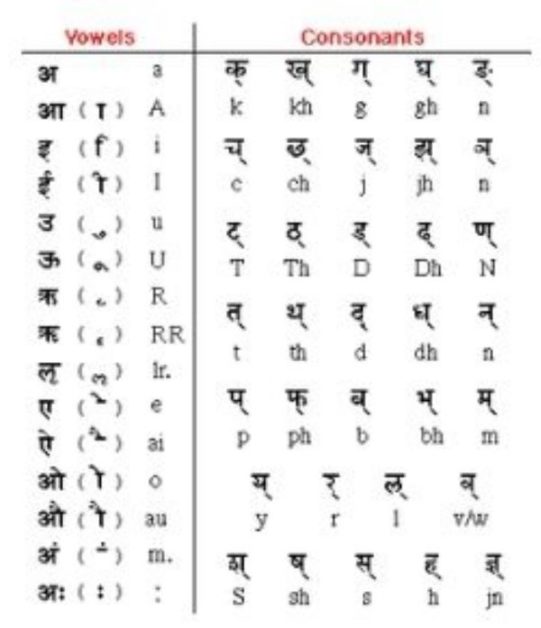Hindi is the main language used in the northern Indian states of Rajasthan, Delhi, Haryana, Uttarakhand, Uttar Pradesh, Madhya Pradesh, Chhattisgarh, Himachal Pradesh, Jharkhand and Bihar. It is spoken in much of north and central India alongside other languages such as Punjabi, Gujarati, Marathi or Bengali. In other parts of India, as well as in Nepal, Bangladesh and Pakistan, Hindi is understood.
Learn Hindi Alphabets
Hindi is spoken in t the Terai lowlands of southern Nepal, and it is spoken in KwaZulu-Natal province in the east of South Africa.
Hindi, written in the Devanagari script, is one of official languages of the government of India – the other offical language is English. Both languages are used in parliament, in the judiciary, in communications between the central government and state government, and for other official purposes.
It is impossible not to use Sanskrit (sam.skRta) words when talking of advaita vedAnta. we have kept philosophical terms, which often have meanings specific to the school of advaita, in the original sam.skRta, instead of translating them into English.
hindi Alphabet Chart

Representation of english and hindi alphabets
| ISO | a | ā | æ | ɒ | i | |||||||
| a | ka | ā | kā | æ | kæ | ɒ | kɒ | i | ki | |||
| Devanagari | अ | क | आ | का | ॲ | कॅ | ऑ | कॉ | इ | कि | ||
| ISO | ī | u | ū | e | ē | ai | ||||||
| ī | kī | u | ku | ū | kū | e | ke | ē | kē | ai | ||
| Devanagari | ई | की | उ | कु | ऊ | कू | ऎ | कॆ | ए | के | ऐ | |
| ISO | o | ō | au | r̥ | r̥̄ | l̥ | ||||||
| kai | o | ko | ō | kō | au | kau | r̥ | kr̥ | r̥̄ | kr̥̄ | l̥ | |
| Devanagari | कै | ऒ | कॊ | ओ | को | औ | कौ | ऋ | कृ | ॠ | कॄ | ऌ |
| ISO | l̥̄ | ṁ | ḥ | |||||||||
| kl̥ | l̥̄ | kl̥̄ | ṁ | kaṁ | ḥ | kaḥ | k | |||||
| Devanagari | कॢ | ॡ | कॣ | अं | कं | अः | कः | क् |
Devanagari digits explained with representation
० १ २ ३ ४ ५ ६ ७ ८ ९
0 1 2 3 4 5 6 7 8 9
Here is the key to the transliteration rules that we follow when we use a sam.skRta word in the middle of English text. This transliteration is by no means perfect, but it is meant for easy online representation in the international Roman alphabet. The intention is to convey a flavor of the original pronunciation of the sam.skRta words. we have avoided the use of additional diacritical marks as much as possible, by making use of upper-case letters. Basic knowledge of the devanAgari script is assumed.
Hindi is closely related to Urdu, the main language of Pakistan, which is written with the Arabic script. Linguists consider Standard Hindi and Standard Urdu to be different formal registers both derived from the Khari Boli dialect, which is also known as Hindustani.
Apart from the difference in writing systems, the other main difference between Hindi and Urdu is that Hindi contains more vocabulary from Sanskrit, while Urdu contains more vocabulary from Persian. At an informal spoken level there are few significant differences between Urdu and Hindi and they could be considered varieties a single language.
Hindi first started to be used in writing during the 4th century AD. It was originally written with the Brahmi script but since the 11th century AD it has been written with the Devanāgarī alphabet. The first printed book in Hindi was John Gilchrist’s Grammar of the Hindoostanee Language which was published in 1796.
Devanāgarī alphabet for Hindi
Vowels (स्वर) and vowel diacritics
Hindi vowels and vowel diacritics